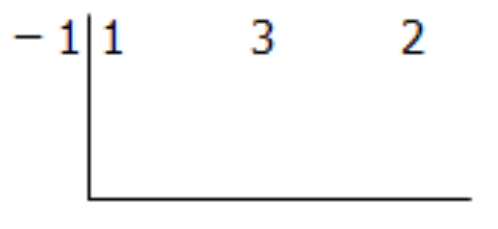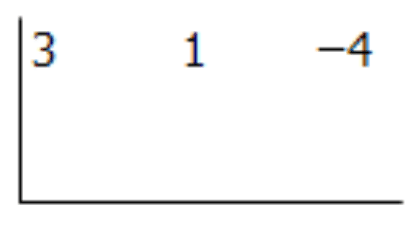2.6.1: Long Division of Polynomials
- Page ID
- 14227
\( \newcommand{\vecs}[1]{\overset { \scriptstyle \rightharpoonup} {\mathbf{#1}} } \)
\( \newcommand{\vecd}[1]{\overset{-\!-\!\rightharpoonup}{\vphantom{a}\smash {#1}}} \)
\( \newcommand{\id}{\mathrm{id}}\) \( \newcommand{\Span}{\mathrm{span}}\)
( \newcommand{\kernel}{\mathrm{null}\,}\) \( \newcommand{\range}{\mathrm{range}\,}\)
\( \newcommand{\RealPart}{\mathrm{Re}}\) \( \newcommand{\ImaginaryPart}{\mathrm{Im}}\)
\( \newcommand{\Argument}{\mathrm{Arg}}\) \( \newcommand{\norm}[1]{\| #1 \|}\)
\( \newcommand{\inner}[2]{\langle #1, #2 \rangle}\)
\( \newcommand{\Span}{\mathrm{span}}\)
\( \newcommand{\id}{\mathrm{id}}\)
\( \newcommand{\Span}{\mathrm{span}}\)
\( \newcommand{\kernel}{\mathrm{null}\,}\)
\( \newcommand{\range}{\mathrm{range}\,}\)
\( \newcommand{\RealPart}{\mathrm{Re}}\)
\( \newcommand{\ImaginaryPart}{\mathrm{Im}}\)
\( \newcommand{\Argument}{\mathrm{Arg}}\)
\( \newcommand{\norm}[1]{\| #1 \|}\)
\( \newcommand{\inner}[2]{\langle #1, #2 \rangle}\)
\( \newcommand{\Span}{\mathrm{span}}\) \( \newcommand{\AA}{\unicode[.8,0]{x212B}}\)
\( \newcommand{\vectorA}[1]{\vec{#1}} % arrow\)
\( \newcommand{\vectorAt}[1]{\vec{\text{#1}}} % arrow\)
\( \newcommand{\vectorB}[1]{\overset { \scriptstyle \rightharpoonup} {\mathbf{#1}} } \)
\( \newcommand{\vectorC}[1]{\textbf{#1}} \)
\( \newcommand{\vectorD}[1]{\overrightarrow{#1}} \)
\( \newcommand{\vectorDt}[1]{\overrightarrow{\text{#1}}} \)
\( \newcommand{\vectE}[1]{\overset{-\!-\!\rightharpoonup}{\vphantom{a}\smash{\mathbf {#1}}}} \)
\( \newcommand{\vecs}[1]{\overset { \scriptstyle \rightharpoonup} {\mathbf{#1}} } \)
\( \newcommand{\vecd}[1]{\overset{-\!-\!\rightharpoonup}{\vphantom{a}\smash {#1}}} \)
\(\newcommand{\avec}{\mathbf a}\) \(\newcommand{\bvec}{\mathbf b}\) \(\newcommand{\cvec}{\mathbf c}\) \(\newcommand{\dvec}{\mathbf d}\) \(\newcommand{\dtil}{\widetilde{\mathbf d}}\) \(\newcommand{\evec}{\mathbf e}\) \(\newcommand{\fvec}{\mathbf f}\) \(\newcommand{\nvec}{\mathbf n}\) \(\newcommand{\pvec}{\mathbf p}\) \(\newcommand{\qvec}{\mathbf q}\) \(\newcommand{\svec}{\mathbf s}\) \(\newcommand{\tvec}{\mathbf t}\) \(\newcommand{\uvec}{\mathbf u}\) \(\newcommand{\vvec}{\mathbf v}\) \(\newcommand{\wvec}{\mathbf w}\) \(\newcommand{\xvec}{\mathbf x}\) \(\newcommand{\yvec}{\mathbf y}\) \(\newcommand{\zvec}{\mathbf z}\) \(\newcommand{\rvec}{\mathbf r}\) \(\newcommand{\mvec}{\mathbf m}\) \(\newcommand{\zerovec}{\mathbf 0}\) \(\newcommand{\onevec}{\mathbf 1}\) \(\newcommand{\real}{\mathbb R}\) \(\newcommand{\twovec}[2]{\left[\begin{array}{r}#1 \\ #2 \end{array}\right]}\) \(\newcommand{\ctwovec}[2]{\left[\begin{array}{c}#1 \\ #2 \end{array}\right]}\) \(\newcommand{\threevec}[3]{\left[\begin{array}{r}#1 \\ #2 \\ #3 \end{array}\right]}\) \(\newcommand{\cthreevec}[3]{\left[\begin{array}{c}#1 \\ #2 \\ #3 \end{array}\right]}\) \(\newcommand{\fourvec}[4]{\left[\begin{array}{r}#1 \\ #2 \\ #3 \\ #4 \end{array}\right]}\) \(\newcommand{\cfourvec}[4]{\left[\begin{array}{c}#1 \\ #2 \\ #3 \\ #4 \end{array}\right]}\) \(\newcommand{\fivevec}[5]{\left[\begin{array}{r}#1 \\ #2 \\ #3 \\ #4 \\ #5 \\ \end{array}\right]}\) \(\newcommand{\cfivevec}[5]{\left[\begin{array}{c}#1 \\ #2 \\ #3 \\ #4 \\ #5 \\ \end{array}\right]}\) \(\newcommand{\mattwo}[4]{\left[\begin{array}{rr}#1 \amp #2 \\ #3 \amp #4 \\ \end{array}\right]}\) \(\newcommand{\laspan}[1]{\text{Span}\{#1\}}\) \(\newcommand{\bcal}{\cal B}\) \(\newcommand{\ccal}{\cal C}\) \(\newcommand{\scal}{\cal S}\) \(\newcommand{\wcal}{\cal W}\) \(\newcommand{\ecal}{\cal E}\) \(\newcommand{\coords}[2]{\left\{#1\right\}_{#2}}\) \(\newcommand{\gray}[1]{\color{gray}{#1}}\) \(\newcommand{\lgray}[1]{\color{lightgray}{#1}}\) \(\newcommand{\rank}{\operatorname{rank}}\) \(\newcommand{\row}{\text{Row}}\) \(\newcommand{\col}{\text{Col}}\) \(\renewcommand{\row}{\text{Row}}\) \(\newcommand{\nul}{\text{Nul}}\) \(\newcommand{\var}{\text{Var}}\) \(\newcommand{\corr}{\text{corr}}\) \(\newcommand{\len}[1]{\left|#1\right|}\) \(\newcommand{\bbar}{\overline{\bvec}}\) \(\newcommand{\bhat}{\widehat{\bvec}}\) \(\newcommand{\bperp}{\bvec^\perp}\) \(\newcommand{\xhat}{\widehat{\xvec}}\) \(\newcommand{\vhat}{\widehat{\vvec}}\) \(\newcommand{\uhat}{\widehat{\uvec}}\) \(\newcommand{\what}{\widehat{\wvec}}\) \(\newcommand{\Sighat}{\widehat{\Sigma}}\) \(\newcommand{\lt}{<}\) \(\newcommand{\gt}{>}\) \(\newcommand{\amp}{&}\) \(\definecolor{fillinmathshade}{gray}{0.9}\)Long Division and Synthetic Division
Can you divide the following polynomials?
\(\ \frac{x^{2}-5 x+6}{x-2}\)
Long Division and Synthetic Division
Polynomial Long Division
Whenever you want to divide a polynomial by a polynomial, you can use a process called polynomial long division. This process is similar to long division for regular numbers. Look at the problem below:
\(\ \frac{\left(x^{2}+3 x+2\right)}{(x+1)}\)
This is the same as the division problem below:

Step 1: Divide the first term in the numerator (x2) by the first term in the denominator (x). Put this result above the division bar in your answer. In this case, \(\ \frac{x^{2}}{x}=x\).

Step 2: Multiply the denominator (x+1) by the result from Step 1 (x), and put the new result below your numerator. Then, subtract to get your new polynomial. This is the same process as in regular number long division!

Step 3: Divide the first term in the new polynomial (2x) by the first term in the denominator (x). Put this result above the division bar in your answer. Multiply, subtract, and repeat this process until you cannot repeat it anymore.
Therefore: \(\ \frac{\left(x^{2}+3 x+2\right)}{(x+1)}=(x+2)\)
Synthetic Division
Synthetic division is another method of dividing polynomials. It is a shorthand of long division that only works when you are dividing by a polynomial of degree 1. Usually the divisor is in the form (x±a). In synthetic division, unlike long division, you are only concerned with the coefficients in the polynomials. Consider the same problem as above:
 [Figure1]
[Figure1]Step 1: Write the coefficients in an upside down division sign.
 [Figure2]
[Figure2]Step 2: Put the opposite of the number from the divisor to the left of the division symbol. In this case, the divisor is x+1, so you will use a −1.

Step 3: Take your leading coefficient and bring it down below the division symbol.
 [Figure4]
[Figure4]Step 4: Multiply this number by the number to the left of the division symbol and place it in the next column. Add the two numbers together and place this new number below the division sign.
 [Figure5]
[Figure5]Step 5: Multiply this second number by the number to the left of the division symbol and place it into the third column. Add the two numbers together and place this new number below the division sign.
 [Figure6]
[Figure6]The numbers below the division sign represent your coefficients. Therefore,
\(\ \frac{\left(x^{2}+3 x+2\right)}{(x+1)}=(x+2)\)
Examples
Earlier, you were asked to divide polynomials:
\(\ \frac{x^{2}-5 x+6}{x-2}\)
Solution
You can use long division or synthetic division.
Long Division:
Step 1: Divide the first term in the numerator by the first term in the denominator, put this in your answer. Therefore \(\ \frac{x^{2}}{x}=x\).
\(\ \begin{array}{c}
\textcolor{red}x\\
(x-2)|\overline{x^2 -5x + 6}
\end{array}\)
Step 2: Multiply the denominator by this number (variable) and put it below your numerator, subtract and get your new polynomial.

Step 3: Repeat the process until you cannot repeat it anymore.

Therefore: \(\ \frac{x^{2}-5 x+6}{x-2}=(x-3)\)
Use long division to divide:
\(\ \frac{x^{2}+6 x-7}{x-1}\)
Solution
Step 1: Divide the first term in the numerator by the first term in the denominator, put this in your answer. Therefore \(\ \frac{x^{2}}{x}=x\).

Step 2: Multiply the denominator by this number (variable) and put it below your numerator, subtract and get your new polynomial.

Step 3: Repeat the process until you cannot repeat it anymore.

Therefore: \(\ \frac{x^{2}+6 x-7}{x-1}=(x+7)\)
Use long division to divide:
\(\ \frac{2 x^{2}+7 x+5}{2 x+5}\)
Solution
Step 1: Divide the first term in the numerator by the first term in the denominator; put this in your answer. Therefore \(\ \frac{2 x^{2}}{2 x}=x\).

Step 2: Multiply the denominator by this number (variable) and put it below your numerator, subtract and get your new polynomial.

Step 3: Repeat the process until you cannot repeat it anymore.

Therefore: \(\ \frac{2 x^{2}+7 x+5}{2 x+5}=(x+1)\)
Use synthetic division to divide:
\(\ \frac{3 x^{2}+x-4}{x-1}\)
Solution
Step 1: Write the coefficients in an upside down division sign.

Step 2: Put the opposite of the number from the divisor to the left of the division symbol.

Step 3: Take your leading coefficient and bring it down below the division symbol.

Step 4: Multiply this number by the number to the left of the division symbol and place it in the next column. Add the two numbers together and place this new number below the division sign.

Step 5: Multiply this second number by the number to the left of the division symbol and place it into the third column. Add the two numbers together and place this new number below the division sign.

Therefore: \(\ \frac{3 x^{2}+x-4}{x-1}=(3 x+4)\)
Review
Use long division to divide each of the following:
- (x2+7x+12)÷(x+3)
- (x2+4x+3)÷(x+3)
- (a2−4a−45)÷(a−9)
- (3x2+5x−2)÷(3x−1)
- (2x2−5x+2)÷(2x−1)
Use synthetic division to divide each of the following:
- (b2−5b+6)÷(b−3)
- (x2−6x+8)÷(x−4)
- (a2−1)÷(a+1)
- (c2−9)÷(c−3)
- (5r2+2r−3)÷(r+1)
Divide each of the following:
- \(\ \frac{2 x^{3}-7 x^{2}-14 x-5}{x-5}\)
- \(\ \frac{9 x^{4}-15 x^{3}+12 x^{2}-11 x-15}{3 x^{3}+4 x+3}\)
- \(\ \frac{6 x^{4}+4 x^{3}+9 x^{2}+2 x+3}{2 x^{2}+1}\)
- \(\ \frac{x^{4}+4 x^{3}+3 x^{2}+x+1}{x+1}\)
- \(\ \frac{2 x^{3}+7 x^{2}-27 x+18}{x+6}\)
- \(\ \frac{8 x^{3}-2 x^{2}+7 x+5}{2 x+1}\)
- \(\ \frac{3 x^{3}-15 x^{2}+4 x-20}{x-5}\)
- \(\ \frac{9 x^{3}+26 x^{2}-48 x+5}{x^{2}+3 x-5}\)
- \(\ \frac{-x^{3}+13 x+12}{x+3}\)
- \(\ \frac{x^{3}-2 x^{2}-5 x+10}{x-2}\)
Vocabulary
| Term | Definition |
|---|---|
| Dividend | In a division problem, the dividend is the number or expression that is being divided. |
| divisor | In a division problem, the divisor is the number or expression that is being divided into the dividend. For example: In the expression 152÷6, 6 is the divisor and 152 is the dividend. |
Image Attributions
- [Figure 1]
Source: https://commons.wikimedia.org/wiki/File:Computer_in_tuition_centre.JPG - [Figure 2]
Source: https://commons.wikimedia.org/wiki/File:Computer_in_tuition_centre.JPG - [Figure 3]
Source: https://commons.wikimedia.org/wiki/File:Computer_in_tuition_centre.JPG - [Figure 4]
Source: https://commons.wikimedia.org/wiki/File:Computer_in_tuition_centre.JPG - [Figure 5]
Source: https://commons.wikimedia.org/wiki/File:Computer_in_tuition_centre.JPG - [Figure 6]
Source: https://commons.wikimedia.org/wiki/File:Computer_in_tuition_centre.JPG


